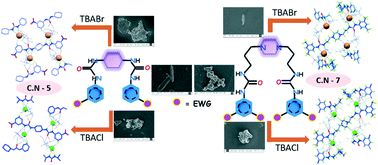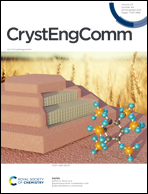Exploring cyclohexane/piperazine-urea motifs for spherical halide (X = Cl−/Br−) recognition: effects on anion coordination, photoluminescence, and morphological tunability†
Abstract
Numerous approaches to receptor fabrication have been introduced for supramolecular anion recognition, not only for academic purposes but also for their substantial application in environmental and biological fields. We highlight halide (X = Cl−/Br−) coordination-triggered self-assembly formation using two dipodal receptors, L1 and L2. This approach involves several non-covalent interactions, such as N–Hurea⋯X, C–Hphenyl⋯X, and C–Hn-TBA⋯X. Structural aspects of the anion-coordinated supramolecular architectures of L1 and L2 (1a, 1b, 2a, 2b) revealed 2 : 1 anion-receptor assembly formation in almost identical fashion, possessing different coordination numbers. Receptor L1 is composed of cyclohexane-urea motifs, whereas L2 comprised a piperazine-urea scaffold connected via a propyl spacer, which might be the backbone of the contrasting coordination number of the isostructural anionic ensembles. Solution-state 1H-NMR and photoluminescence studies corroborated the efficient encapsulation of chloride/bromide via hydrogen bonding interactions. FESEM studies depicted the variations in morphologies in the anion-recognition-triggered self-assembly of the receptors.

- This article is part of the themed collection: Supramolecular & Polymorphism


 Please wait while we load your content...
Please wait while we load your content...